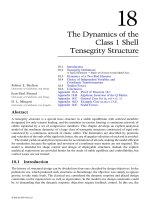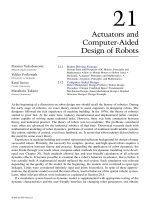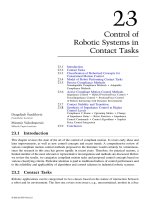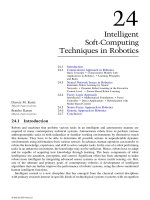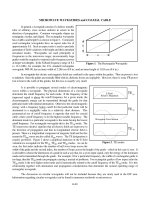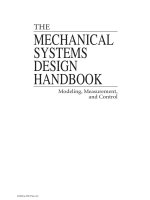Tài liệu Modeling, Measurement and Control P1 pptx
Bạn đang xem bản rút gọn của tài liệu. Xem và tải ngay bản đầy đủ của tài liệu tại đây (429.4 KB, 11 trang )
-1
I
Manufacturing
A. Galip Hulsoy
8596Ch01Frame Page -1 Tuesday, November 6, 2001 10:22 PM
© 2002 by CRC Press LLC
1
Manufacturing Systems
and Their
Design Principles
1.1 Introduction
1.2 Major Manufacturing Paradigms and
Their Objectives
1.3 Significance of Functionality/Capacity
Adjustments in Modern Manufacturing Systems
1.4 Critical Role of Computers in Modern
Manufacturing
1.5 Design Principles of Modern Manufacturing
Systems
Product Design and Design for Manufacturability •
Process Planning and System Design of Manufacturing
Systems • Software/Hardware Architecture and
Communications in Manufacturing Systems • Monitoring
and Control of Manufacturing Systems
1.6 Future Trends and Research Directions
1.1 Introduction
Manufacturing has always been the key to success among nations in the world economy (Figure 1.1).
A responsive manufacturing system working in harmony with the rest of an enterprise has a major
impact on its competitiveness; it plays a vital role in the successful introduction of new products or
continuous improvements of existing products in response to demands of the market (Cohen, 1987).
A wide variety of items are produced by manufacturing firms, depending upon the market
demands they may be custom made or mass produced. Manufacturing systems used for their
production are designed and tailored to specific requirements. Consequently, several manufacturing
techniques are adopted to address new market demands.
This chapter is devoted to a high-level overview of manufacturing techniques, their objectives
and design principles. In this regard, some of the available manufacturing techniques are explained
and their achievements, advantages, and limitations are discussed. Due to the significant impact of
computers on manufacturing, an effort is made to introduce the role of computers and information
technology in modern manufacturing systems. In this regard, applications and functions of com-
puters in various stages of product design, generation of the sequence of operations and process
planning, control of the machines and monitoring of the processes (on/off line), automation,
networking and communication systems, and quality control of the production systems are
explained. Later in the chapter, the design principles of manufacturing systems and their components
M. G. Mehrabi
University of Michigan
A. Galip Ulsoy
University of Michigan
Yoram Koren
University of Michigan
8596Ch01Frame Page 1 Tuesday, November 6, 2001 10:22 PM
© 2002 by CRC Press LLC
are presented as well as some of the issues related to their enabling technologies and barriers. The
chapter concludes with a discussion of some of the future directions in manufacturing systems.
1.2 Major Manufacturing Paradigms and Their Objectives
New technological developments and market demands have major impacts on manufacturing. As
a result, several shifts in the focus of manufacturing processes can be observed, which can be
conveniently divided into three major epochs: (1) precomputer numerical control, (2) computer
numerical control (CNC), and (3) knowledge epochs (Mehrabi and Ulsoy, 1997; Mehrabi, Ulsoy,
and Koren, 1998). In the pre-CNC epochs (before the 1970s), the emphasis was on increased
production rate; little demand existed for product variations and the market was characterized by
local competition. Mass production uses dedicated lines designed for production of a specific part;
it uses transfer line technology with fixed tooling and automation. The objective is to cost-effectively
produce one specific part type at high volumes and with the required quality.
The emphasis on cost-effective production was supplemented with a focus on improved product
quality in the CNC epoch (the 1970s and 1980s). Manufacturing was dramatically affected by the
invention of CNC machines as they provide more accurate control and means for better quality.
Japanese production techniques such as Kaizen (continuous improvement); just-in-time (JIT) (elim-
ination/minimization of inventory as the ideal goal to reduce costs); lean manufacturing (efficiently
eliminate waste, reduce cost, and improve quality control; and total quality management (TQM)
(increased and faster communications with customers to meet their requirements) attracted consid-
erable attention. Furthermore, CNC machines provided necessary tools for easier integration/auto-
mation which, in turn, contributed to manufacturing of a product family on the same system.
Consequently, flexible manufacturing systems (FMSs) were introduced to address changes in work
orders, production schedules, part programs, and tooling for the production of a family of parts.
The economic objective of an FMS (see Figure 1.2) is to make possible the cost-effective manu-
facture of several types of parts that can change over time, with shortened changeover time, on the
same system at the required volume and quality. It has a fixed hardware and fixed (but program-
mable) software (see Figure 1.3). In terms of design, the system possesses an integral architecture
(hardware/software), i.e., the boundaries between the components and their functionalities are often
difficult to identify and are tightly linked together. This type of architecture does not allow for
reconfiguration changes to be made. Therefore, an FMS has limited capabilities for upgrading, add-
ons, customization, and changes in production capacity.
In the knowledge epoch (i.e., starting in the 1990s), focus shifted to the responsiveness of a manu-
facturing system characterized by intensified global competition, the fast pace of technological inno-
vations, and enormous progress in computer and information technology (Jaikumar, 1993; Mehrabi
FIGURE 1.1
Despite assertions that the U.S. is becoming a service industry, manufacturing has consistently
accounted for about 22% of GDP. (Source: U.S. Bureau of Labor Statistics.)
8596Ch01Frame Page 2 Tuesday, November 6, 2001 10:22 PM
© 2002 by CRC Press LLC
and Ulsoy, 1997; Mehrabi, Ulsoy, and Koren, 1998). Rapid progress was made in areas such as
management information systems, development of software/application programs for various spe-
cific purposes, advances in communication systems (hardware and software), and penetration of
computer technology in various fields (Gyorki, 1989). Therefore, global competition and informa-
tion technology are the driving forces behind recent changes in manufacturing. These conditions
FIGURE 1.2
Economic goals for various manufacturing paradigms.
FIGURE 1.3
Key hardware and software features of manufacturing systems.
Reduce
Product Cost
Mass
Lean
Flexible
Increase Product
Variety
Reconfigurable
Increase
Manufacturing Process
Responsiveness
Competitive Market
Advantages
Product
Functions and
Performance
Improve
Product
Quality
Reconfigurable
Software
Reconfigurable
Machines w.
Reconfigurable
Controllers
No
Software
Fixed
Software
Reconfigurable
Hardware
Fixed
Hardware
Manual Machines
Dedicated Lines
CNC, Robots
F M S
———
Convertible Lines
Modular Machines
———
Modular
Open-Architecture
Controller
R M S
R M S
System Configuration
Rules & Economics
8596Ch01Frame Page 3 Tuesday, November 6, 2001 10:22 PM
© 2002 by CRC Press LLC
require a responsive manufacturing system that can be rapidly designed, able to convert quickly to
the production of new product models, able to adjust capacity quickly, able to integrate process
technology, and able to produce an increased variety of products in unpredictable quantities. Agile
manufacturing (Goldman, Nagel, and Preiss, 1995) was introduced as a new approach to respond
to rapid change due to competition. It brings together individual companies to form an enterprise
of manufacturers and their suppliers linked via advanced networks of computers and communication
systems. Agile manufacturing, however, does not deal with production system technology or
operations.
More recently, reconfigurable manufacturing systems (RMSs) were introduced (Koren and Ulsoy,
1997; Mehrabi and Ulsoy, 1997) to respond to the new market-oriented manufacturing environment.
In terms of design, an RMS has a modular structure (software and hardware) that allows ease of
reconfiguration as a strategy to adapt to market demands (see Table 1.1). Open-architecture control
systems are one of the key enabling technologies of an RMS, and have the ability to integrate/remove
new software/hardware modules without affecting the rest of the system. Another key enabling
technology is modular machines (Moon and Kota, 1998; Garro and Martin, 1993). System design
tools are also needed to properly configure a system from these software and hardware building
blocks (see Figure 1.3). This means an RMS has the ability to be converted quickly to the production
of new models, to be adjusted rapidly to exact capacity requirements as the market grows and
product changes, and to integrate new technology. The objective of an RMS is to provide the
functionality and capacity that is needed, when it is needed. Thus, a given RMS configuration can
be dedicated or flexible, and can change as needed. An RMS goes beyond the economic objectives
of an FMS by permitting: (1) reduction of lead time for launching new systems and reconfiguring
existing systems, and (2) the rapid manufacturing modification and quick integration of new
technology and/or new functions into existing systems.
1.3 Significance of Functionality/Capacity Adjustments
in Modern Manufacturing Systems
Due to the globalization of economies, responsiveness is becoming the cornerstone of manufac-
turing competitiveness. Therefore, rapid, controlled-cost response to market demands is the key to
the success of manufacturing companies. This section is devoted to discussion of the abilities of
TABLE 1.1
Summary of Definitions
Systems
(Machining/Manufacturing) Definitions
Machining System One or more machine tools and tooling, and auxiliary equipment (e.g., material handling,
control, communications) that operate in a coordinated manner to produce parts at the
required volumes and quality.
Dedicated Machining System
(DMS)
A machining system designed for production of a specific part, and uses transfer line
technology with fixed tooling and automation.
Flexible Manufacturing
System (FMS)
A machining system configuration with fixed hardware and fixed, but programmable,
software to handle changes in work orders, production schedules, part programs, and
tooling for several types of parts.
Reconfigurable
Manufacturing System
(RMS)
A machining system that can be created by incorporating basic process modules, both
hardware and software, that can be rearranged or replaced quickly and reliably.
Reconfiguration will allow adding, removing, or modifying specific process capabilities,
controls, software, or machine structure to adjust production capacity in response to
changing market demands or technologies. This type of system will provide customized
flexibility for a particular part family, and will be open-ended, so that it can be improved,
upgraded, and reconfigured, rather than replaced.
Note:
A part family is defined as one or more part types with similar dimensions, geometric features, and tolerances,
such that they can be produced on the same, or similar, production equipment.
8596Ch01Frame Page 4 Tuesday, November 6, 2001 10:22 PM
© 2002 by CRC Press LLC
available manufacturing systems in terms of the rapid adjustment of capacity and functionality in
response to the market demands. Figure 1.4 provides mapping of the available manufacturing
systems in capacity-functionality coordinates. As is shown, dedicated transfer lines typically have
high capacity but limited functionality (Koren and Ulsoy, 1997). They are cost effective as long as
they produce a limited number of part types and demand exceeds supply. But with saturated markets
and the increasing pressure of global competition, situations exist where the dedicated lines do not
operate at their full capacity, which creates a loss. Flexible systems, on the other hand, are built
with all the flexibility and functionality available, including some cases that may not be needed at
installation time. In these cases, capital lies idle on the shop floor and a major portion of the capital
investment is wasted. These two types of waste will be eliminated with RMS technology. In the
first case, the RMS allows the addition of the extra capacity when required, and in the second case,
adds functionality when needed. Referring again to the capacity vs. functionality trade-off in
Figure 1.4, the RMSs may, in many cases, occupy a middle ground between DMSs and FMSs.
This also raises the possibility of various types of RMSs, with different granularity of the RMS
modules that evolve from either DMSs or FMSs, respectively. For example, an RMS can be designed
with a CNC machine tool as the basic building block. This would require an evolution of current
FMSs through lower-cost, higher-velocity CNC machine tools with modular tooling that also have
in-process measurement systems to assure consistent product quality. On the other hand, an RMS
can be designed with drive system modules, rather than CNC machines, as the basic building
blocks. This would represent an evolution of RMSs from DMSs and require, for example, modular
machine tool components and distributed controllers with high bandwidth communication.
1.4 Critical Role of Computers in Modern Manufacturing
A number of steps are involved in manufacturing a part from its conceptualization to production.
They include product design, process planning, production system design, and process control.
Computers are used extensively in all these stages to make the entire process easier and faster.
Potential benefits of using computers in manufacturing include reduced costs and lead times in all
engineering design stages, improved quality and accuracy, minimization of errors and their dupli-
cation, more efficient analysis tool, and accurate control and monitoring of the machines/processes,
etc. Some of the applications of computers in manufacturing are shown in Figure 1.5. In computer-
aided design (CAD), computers are used in the design and analysis of the products and processes.
They play a critical role in reducing lead time and cost at the design stages of the products/process.
Also, computers may be utilized to plan, manage, and control the operations of a manufacturing
system: computer-aided manufacturing (CAM) (Bedworth, Handerson, and Wolfe, 1991). In CAM,
computers are either used directly to control and monitor the machines/processes (in real-time) or
used off-line to support manufacturing operations such as computer-aided process planning (CAPP)
FIGURE 1.4
Mapping several types of manufacturing systems in capacityfunctionality coordinates.
Dedicated
transfer
lines
Flexible
Manufacturing
Systems
Functionality (product variety)
Capacity
(part/year)
Reconfigurable
Manufacturing
Systems
8596Ch01Frame Page 5 Tuesday, November 6, 2001 10:22 PM
© 2002 by CRC Press LLC
or planning of required materials. At higher levels, computers are utilized in support of management.
They play a critical role in all stages of decision making and control of financial operations by
processing and analyzing data and reporting the results (management information systems, MIS)
(Hollingam, 1987). Computers facilitate integration of CAD, CAM, and MIS (computer-integrated
manufacturing, CIM) (Vajpayee, 1995) (see Figure 1.5). They provide an effective communication
interface among engineers, design, management, production workers, and project groups to improve
efficiency and productivity of the entire system.
1.5 Design Principles of Modern Manufacturing Systems
Manufacturing is a complex process that begins with evaluating the market and investigating the
demands for a product, and ends with delivery of the actual product. Successful marketing should
take into account the factors that affect current and future demands for a product. It provides
management with appropriate inputs for decision making and directing resources of a company
toward production of a part that is needed in the market. This sets the stage for product design and
manufacturing as described in the following sections.
1.5.1 Product Design and Design for Manufacturability
At the product design stage, designers and product engineers generate new ideas and study various
aspects of design. Also, production engineers investigate the availability of the resources and
capabilities of the production system. CAD systems are extensively used at this stage for rapid
design and revisions of a product (Groover and Zimmers, 1984). Designs for manufacturability
(DFM) and assembly are used to emphasize the significance of the links between design of a
product and its manufacturing (Beckert, 1990). Design for manufacturing focuses on appropriate
product design, process planning, and manufacturing to ensure optimum results (Vajpayee, 1995).
It emphasizes the importance of quality and its relation with the machines/processes accuracy of
machined (produced) parts tolerances, and correction of a product defect at the design stage (as
opposed to after production) and its significant impact on cost of a product.
FIGURE 1.5
Applications of computer technology in manufacturing.
CAD
Product design:
Part model, dimensions,
geometric feature
Requirements:
Tolerances, accuracy, materials
Analysis and Design:
Finite element, structural
design
(stiffness properties)
Kinematic /dynamic analysis
CAM
Tool and Fixture Data:
Tool geometry, material, dimensions,
geometric features
NC Program:
Generating, tool path generation/verification
Computer-Aided Process
Planning(CAPP):
Machining operations, process/cutting data,
Sequences of operations
Machine/Process Control/Monitoring:
Real-time control, PLCs,
quality/inspection
Measurement systems
MIS
(Management Information Systems)
Production Planning:
Production control, inventory control,
Materials, purchasing
Marketing:
Forecast, analysis, sales, pricing
Human Resources:
Financial, skill requirements
CIM
8596Ch01Frame Page 6 Tuesday, November 6, 2001 10:22 PM
© 2002 by CRC Press LLC
1.5.2 Process Planning and System Design of Manufacturing Systems
Once a product design is completed, it is produced by using machines and other equipment (e.g.,
material handling) and resources. Computers are used extensively to identify optimal machining
configurations by taking into account the cost, quality, and reliability of the entire system (see
Figure 1.6), control the activities of planning and distributing the sequence of operations among
the machines, and to specify machining parameters such as feed, speed, etc., computer-aided process
planning (CAPP) (Bedworth, Handerson, and Wolfe, 1991; Vajpayee, 1995).
Two basic approaches to CAPP exist, variant and regenerative. The variant technique is used
mostly for process planning of a family of products. With this technique, group technology (GT)
is used to create and classify the plans (for a family of parts), and store them in a database. For
the next design, the required plans are retrieved from the database already created for this family
of parts (Groover and Zimmers, 1984). With the regenerative method, process plans are produced
for every new product and as such, no database of plans exists (Gyorki, 1989; Vajpayee, 1995). It
is more sophisticated than the variant method and has the advantage of facilitating integration of
process planning stage with product design while the needs for human experts are minimized or
totally eliminated.
1.5.3 Software/Hardware Architecture and Communications
in Manufacturing Systems
An integral part of a manufacturing system is the software required to handle tasks at various levels
such as control, monitoring, and communications among mechanical, electrical, and electronic
components (low level) as well as higher level tasks such as process planning, user interface, process
control, data collection/report from the process, etc. Therefore, the structure and functionality of
the control software are very critical and directly affect the performance of the entire system. The
controllers of the machines, networking and data communication between CNC controller/PLC
(programmable logic controllers) or PLC/PLC, have been through proprietary networks (similar
situation as with controllers); i.e., related control systems, communication systems, protocols, and
software/hardware are not open to users or other vendors (Aronson, 1997; Altintas and Munasinghe,
1996). Therefore, further system enhancements, integration of sensors, and new technologies are
severely restricted. Open-architecture principles and systems are introduced to accommodate these
features (see Figure 1.7).
Another critical issue in the design of modern intelligent manufacturing systems is communica-
tion. Let us consider a set of sensors/devices communicating with a central computer/controller.
Traditionally, they should be hard-wired to the central controller/PLC; therefore, the costs associated
with wiring, connections, control cabinet, space, labor, maintenance, and trouble shooting are quite
FIGURE 1.6
Several possible configurations with four machines.
Serial line
(least expensive, least reliable)
Parallel line
(most expensive, easy to add functionality)
Hybrid line
8596Ch01Frame Page 7 Tuesday, November 6, 2001 10:22 PM
© 2002 by CRC Press LLC
high. With a proper communication system, the same sensor/device is connected to a network
(locally) which takes care of all data reporting and condition monitoring of the entire manufacturing
system.
Recent developments in built-in intelligent control devices and communication networks, such
as Devicenet, address some of these issues (Proctor and Albus, 1997; Proctor and Micholski, 1993).
In the Devicenet network, local devices have built-in intelligence (with little cost) and their
communication capabilities are enhanced. Therefore, control decisions/actions are made locally
and the entire control system for manufacturing is decentralized. Also, progress is made in the
development of standard terminology for message and instruction sets, such as manufacturing
message specification (MMS), which is necessary for shop floor communication.
1.5.4 Monitoring and Control of Manufacturing Systems
One of the key factors in evaluating product quality is precision in machining. To achieve that, the
cutting operation is tightly controlled by using real-time data collected from sensors located at
different locations of the workpiece, tool, and machine. Also, some measurements are made for
process monitoring purposes with the objective of preventing irrepairable damages to the workpiece
and the machine. In general, real-time measurements of the following variables are required:
dimensional errors, quality of surface finish, thermal deformations during machining, and dynamic
deformations of the workpiece; chatter vibration, cutting force, condition of the chip, and identi-
fication of the cutting for process monitoring; thermal deformation, dynamic deformation of the
machine elements, and structural vibration of the machine tool and wear, failure, and thermal
deformations of the tool (Rangwala and Dornfeld, 1990; Li and Elbestawi, 1996).
Currently, commercially available controllers of CNC machines have been equipped with pro-
prietary control systems; i.e., the users do not have access to the controller and further modifica-
tions/enhancements of the system (by the users) are either impossible or very costly. This has
significantly hindered the applications of efficient control algorithms, addition of new sensors for
process improvement/monitoring purposes, and has suppressed the automation of the entire pro-
duction system. PC-based control systems (Koren et al., 1998; Hollenback, 1996) are the answer
to the limitations mentioned above; they are very suitable for operating in an open-architecture
environment (see Figure 1.7).
The same view is valid for programmable logic controllers (PLCs). To date, PLCs have been
used in industrial automation to control and monitor discrete event systems. The functionality of
PLCs can be enhanced, however, by proper implementation of available I/O boards (and compatible
software) on a much more compact and industrial PC platform such as PC/104. This offers the
advantage of integrating the functional logic (discrete) of PLCs and machine-tools’ motion control
(continuous) by utilizing modeling capabilities of Petri nets (Park et al., 1998) (see Figure 1.8).
FIGURE 1.7
Open-architecture principle in machine tool control systems.
8596Ch01Frame Page 8 Tuesday, November 6, 2001 10:22 PM
© 2002 by CRC Press LLC
1.6 Future Trends and Research Directions
It is very difficult to forecast long-term trends for manufacturing systems, because the changes are
happening at a very fast pace. However, it is possible to extrapolate future trends from the current
situation by analyzing and specifying the key drivers behind the changes. Certainly, availability
and distribution of information play an important role in this transition and are considered key
drivers. In this regard, the need for improvements and standardization of various components (such
as data interfaces, protocols, communication systems, etc.) exists so that data can be transferred to
the desired location at a faster rate (Agility Forum, 1997).
There are many research efforts underway; however, we are still at the beginning of a new era of
modern manufacturing systems, and there are many barriers to their advancement. Advances in man-
ufacturing will not occur without the proper machine tools and equipment. Machine tools are under-
going some fundamental changes in terms of their structure (modular structure) and components
(controllers, hardware/software, spindles, tooling, sensors, etc.). Therefore, new theories, design con-
cepts, and methodologies should be developed for these purposes (Garro and Martin, 1993; Lee, 1997;
Moon and Kota, 1998). These changes are fundamental to the success of future manufacturing systems.
Selected References
Agility Forum, 1997,
Next-Generation Manufacturing: A Framework for Action
, Bethlehem, PA.
Altintas, Y. and W.K. Munasinghe, 1996, A hierarchical open-architecture CNC system for machine
tools,
Annals of the CIRP
, 43, 1, 349–354.
Aronson, R.B., 1997, Operation plug-and-play is on the way,
Manufacturing Engineering
, 118, 3,
108–112.
Beckert, B., 1990, Integrated manufacturing: New wizards of management,
Industry Week
, 239, 6, 60–84.
Bedworth, D.D., Handerson, M.R., and P. Wolfe, 1991,
Computer Integrated Design and Manufacturing
,
McGraw-Hill, New York.
Cohen, S.S., 1987,
Manufacturing Matters: The Myth of the Post-Industrial Economy
, Basic Books, New
York.
FIGURE 1.8
Examples of modeling capabilities of Petri nets.
t1
t2
(a) Conflict: if t1 fires, t2 is not enabled and visa versa
t1
t2
(b) Concurrency: t1and t2 can be fired
independently
8596Ch01Frame Page 9 Tuesday, November 6, 2001 10:22 PM
© 2002 by CRC Press LLC
Garro, O., and P. Martin, 1993, Towards new architecture of machine tools,
International Journal of
Production Research
, 31, 10, 2403–2414.
Goldman, S.L., Nagel, R.N., and K. Preiss, 1995,
Agile Competitors and Virtual Organizations: Strategies
for Enriching the Customer
, Van Nostrand Reinhold, New York.
Groover, M. and E.W. Zimmers, 1984,
CAD/CAM, Computer-Aided Design and Manufacturing
, Prentice
Hall, Englewood Cliffs, New Jersey.
Gyorki, J.R., 1989, How to succeed CIM,
Machine Design
, 42, 1, 99–105.
Hollenback, D., 1996, PCs provide the foundation for open architecture,
Control Engineering
, 75–78.
Hollingum, J., 1987,
Implementing an Information Strategy in Manufacturing
, IFS Publication, UK.
Jaikumar, R., 1993, 200 years to CIM,
IEEE Spectrum,
26–27.
Koren,Y., Jovane, F., and G. Pritschow (Eds.), 1998,
Open Architecture Control Systems
, ITIA Series,
Italy.
Koren, Y. and A.G. Ulsoy, 1997, Reconfigurable Manufacturing Systems, Engineering Research Center
for Reconfigurable Machining Systems (ERC/RMS) Report #1, The University of Michigan, Ann
Arbor.
Lee, G.H., 1997, Reconfigurability consideration design of components and manufacturing systems,
International Journal of Advanced Manufacturing Technology
, 13, 5, 376–386.
Li, S., and M.A. Elbestawi, 1996, Tool condition monitoring in machining by fuzzy neural networks,
ASME Journal of Dynamic Systems, Measurement, and Control
, 118, 4, 665–672.
Mehrabi, M.G., Ulsoy, A.G., and Y. Koren, 1998, Reconfigurable manufacturing systems: Key to future
manufacturing,
Proceedings of the 1998 Japan–U.S. Symposium on Flexible Automation
, Otsu,
Japan, 677–682.
Mehrabi, M.G. and A.G. Ulsoy, 1997, State-of-the-Art in Reconfigurable Manufacturing Systems,
ERC/RMS Report #2, Vol. I, Engineering Research Center for Reconfigurable Machining Systems
(ERC/RMS), The University of Michigan, Ann Arbor.
Moon, Y. and S. Kota, Generalized kinematic modeling method for reconfigurable machine tools,
ASME
DETC 98
, Atlanta, GA, Paper number MECH-5946, Sept. 1998.
Park, I., D. Tilbury, and P.P. Khargonekar, 1998, A Formal Implementation of Logic Controllers for
Machining Systems Using Petri Nets and Sequential Function Charts, presented at the 1998
Japan–U.S. Symposium on Flexible Automation, Otsu, Japan.
Proctor, F.M. and J.S. Albus, 1997, Open-architecture controllers,
IEEE Spectrum,
34, 6, 60–64.
Proctor, F.M. and J. Micholski, 1993, Enhanced Machine Controller Architecture Overview, NISTIR-
5331, NIST Tech. Rep., Gaitherburg, MD.
Rangwala, S. and D.A. Dornfeld, 1990, Sensor integration using neural networks for intelligent tool
condition monitoring,
ASME Journal of Engineering for Industry
, 112, 219–228.
Vajpayee, K. 1995,
Principles of Computer-Integrated Manufacturing
, Prentice Hall, Englewood Cliffs,
New Jersey.
8596Ch01Frame Page 10 Tuesday, November 6, 2001 10:22 PM
© 2002 by CRC Press LLC
